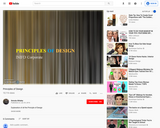
Different Principles of Fashion Style.
- Subject:
- Arts and Humanities
- Material Type:
- Homework/Assignment
- Author:
- Amruta Athaley
- Date Added:
- 08/29/2019

Different Principles of Fashion Style.
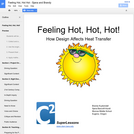
This project will be focused on designing, constructing and evaluating different containers to determine the optimal design for heat retention. After students have constructed their designs and collected and shared data, students will evaluate the class data to create an optimal design for our culminating event: warming ooey, gooey chocolate chip cookies to perfection! Through this activity, students will learn about energy transfer, engineering design process, data collection, graphing, rate of change, optimization, surface area and proportions. The students will test the effectiveness of their design using Vernier Probes to gather quantitative data and graphing the rate of temperature change. They will then create a poster presentation to share their data to the class. Students will use their mathematical skills to quantitatively analyze the strength and weaknesses of their designs while enjoying some delicious, toasty, warm cookies.
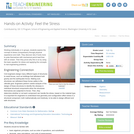
Working individually or in groups, students explore the concept of stress (compression) through physical experience and math. They discover why it hurts more to poke themselves with mechanical pencil lead than with an eraser. Then they prove why this is so by using the basic equation for stress and applying the concepts to real engineering problems.
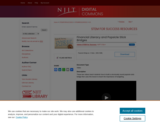
These two videos teach students how to build a structurally sound popsicle stick bridge then uses this lesson to teach the importance of budgeting.

The purpose of Design Dilemma is to encourage students to use resourceful and creative behaviors to think like a scientist. Students will demonstrate these behaviors to design and build a suitable structure for a fourth little pig. Although the use of the book The Fourth Little Pig is helpful, the module may be taught without it. This module is meant for all students. The classroom teacher should work with a specialist or special educator to find or develop alternate activities or resources for visually impaired students, where appropriate.
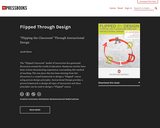
The “Flipped Classroom” model of instruction has generated discussion around the world of education. Numerous articles have been written documenting experiences surrounding this method of teaching. The one piece that has been missing from this discussion is a sound framework to design a “Flipped” course using proven design principles. Instructional Design provides a proven framework to design all types of instruction and these principles can be used to design a “Flipped” course.
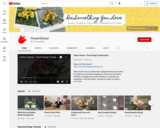
FlowerSchool is a free video library produced by Floral Design Institute. Education Director Leanne Kesler AIFD demonstrates several innovative floral designs in an easy to learn, step-by-step method.

During this engineering design/build project, students investigate many different solutions to a problem. Their design challenge is to find a way to get school t-shirts up into the stands during home sporting events. They follow the steps of the engineering design process to design and build a usable model, all while keeping costs under budget.
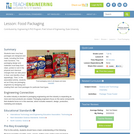
This lesson focuses on how food packages are designed and made. Students will learn three of the main functions of a food package. They will learn what is necessary of the design and materials of a package to keep food clean, protect or aid in the physical and chemical changes that can take place in a food, and identify a food appealingly. Then, in the associated activity, the students will have the opportunity to become packaging engineers by designing and building their own food package for a particular type of food.

Short Description:
Foundation Drawing for Art 1100 serves as the primary text for the course of the same name at the UNO School of the Arts.
Word Count: 13003
(Note: This resource's metadata has been created automatically by reformatting and/or combining the information that the author initially provided as part of a bulk import process.)
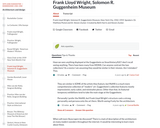
Frank Lloyd Wright, Solomon R. Guggenheim Museum, New York City, 1942-1959. Speakers: Dr. Matthew Postal and Dr. Steven Zucker. Created by Beth Harris and Steven Zucker.
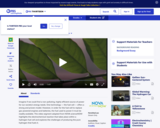
In this video segment adapted from NOVA scienceNOW, hydrogen fuel cell cars promise pollution-free driving, but will we see them anytime soon?

This class covers the history of 20th century art and design from the perspective of the technologist. Methods for visual analysis, oral critique, and digital expression are introduced. Class projects this term use the OLPC XO (One Laptop Per Child) laptop, Csound and Python software.

The book series Microwave and RF Design is a comprehensive treatment of radio frequency (RF) and microwave design with a modern “systems-first” approach. A strong emphasis on design permeates the series with extensive case studies and design examples. Design is oriented towards cellular communications and microstrip design so that lessons learned can be applied to real-world design tasks. The books in the Microwave and RF Design series are: Radio Systems (Volume 1), Transmission Lines (Volume 2), Networks (Volume 3), Modules (Volume 4), and Amplifiers and Oscillators (Volume 5).
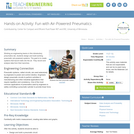
Working as engineering teams in this introductory pneumatics lab, students design and build working pneumatic (air-powered) systems. The goal is to create systems that launch balls into the air. They record and analyze data from their launches.

Furniture making is in many ways like bridge building, connections holding posts apart with spans to support a deck. Many architects have tried their hand at furniture design, Wright, Mies Van Der Rohe, Aalto, Saarinen, Le Corbusier, and Gerhy.
We will review the history of furniture making in America with a visit to the Decorative Arts Collection at the Museum of Fine Arts in Boston and have Cambridge artist/craftsman Mitch Ryerson show us his work and talk about design process. Students will learn traditional woodworking techniques beginning with the use of hand tools, power tools and finally woodworking machines.
Students will build a single piece of furniture of an original design that must support someone weighing 185 lbs. sitting on it 12 inches off the ground made primarily of wood. Students should expect to spend approximately 80 hours in the shop outside of class time.
Preregistered architecture students will get first priority but first meeting attendance is mandatory. Twelve student maximum, no exceptions.

This course is built around practical instruction in the design and analysis of non-digital games. It provides students the texts, tools, references, and historical context to analyze and compare game designs across a variety of genres. In teams, students design, develop, and thoroughly test their original games to better understand the interaction and evolution of game rules. Covers various genres and types of games, including sports, game shows, games of chance, card games, schoolyard games, board games, and role-playing games.

Create 100 icons variations that fit a central theme for a Gameboy-style icon set, such foods, hero portraits, spells, enemies, or robots.

This course focuses on the algorithms for analyzing and designing geometric foldings. Topics include reconfiguration of foldable structures, linkages made from one-dimensional rods connected by hinges, folding two-dimensional paper (origami), and unfolding and folding three-dimensional polyhedra. Applications to architecture, robotics, manufacturing, and biology are also covered in this course.
Acknowledgments
Thanks to videographers Martin Demaine and Jayson Lynch.
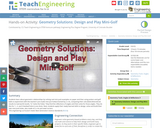
Students learn about geometric relationships by solving real mini putt examples on paper and then using putters and golf balls to experiment with the teacher’s pre-made mini put hole(s) framed by 2 x 4s, comparing their calculated (theoretical) results to real-world results. To “solve the holes,” they find the reflections of angles and then solve for those angles. They do this for 1-, 2- and 3-banked hole-in-one shots. Next, students apply their newly learned skills to design, solve and build their own mini putt holes, also made of 2 x 4s and steel corners.